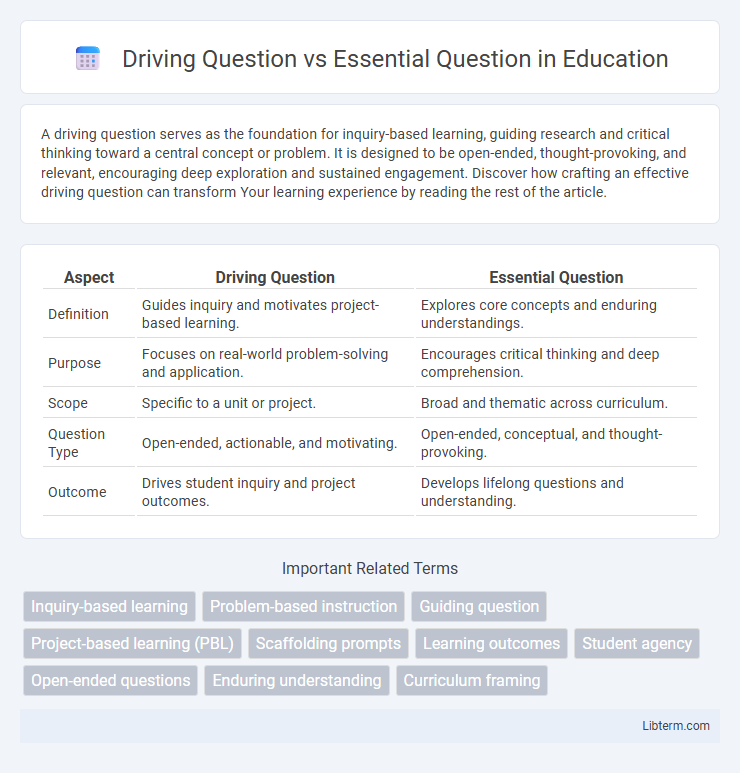A driving question serves as the foundation for inquiry-based learning, guiding research and critical thinking toward a central concept or problem. It is designed to be open-ended, thought-provoking, and relevant, encouraging deep exploration and sustained engagement. Discover how crafting an effective driving question can transform Your learning experience by reading the rest of the article.
Table of Comparison
| Aspect | Driving Question | Essential Question |
|---|---|---|
| Definition | Guides inquiry and motivates project-based learning. | Explores core concepts and enduring understandings. |
| Purpose | Focuses on real-world problem-solving and application. | Encourages critical thinking and deep comprehension. |
| Scope | Specific to a unit or project. | Broad and thematic across curriculum. |
| Question Type | Open-ended, actionable, and motivating. | Open-ended, conceptual, and thought-provoking. |
| Outcome | Drives student inquiry and project outcomes. | Develops lifelong questions and understanding. |
Introduction to Driving and Essential Questions
Driving questions are inquiry-based prompts designed to guide students' exploration and problem-solving throughout a project, focusing on real-world relevance and student engagement. Essential questions, by contrast, are broad, conceptual questions that stimulate deeper understanding and inquiry into fundamental ideas within a subject area. Both types of questions serve as foundational tools in education, shaping curriculum and fostering critical thinking skills from introduction to mastery.
Defining Driving Questions
Driving questions are open-ended inquiries designed to guide exploration and inquiry in project-based learning, targeting real-world problems to foster student engagement and critical thinking. These questions are specific, actionable, and framed to drive sustained investigation, often framed as challenges or problems to solve. Unlike essential questions, driving questions center on motivating tangible outcomes and direct learning activities within a defined scope.
Understanding Essential Questions
Essential Questions guide deeper inquiry by encouraging critical thinking and ongoing exploration of core concepts, unlike Driving Questions which often focus on specific tasks or problems. They are open-ended, designed to promote student understanding and connect learning to broader themes and enduring understandings. Effective Essential Questions stimulate reflection, require justification, and provoke further discussion, serving as foundational tools in curriculum design.
Key Differences Between Driving and Essential Questions
Driving questions are specifically designed to guide inquiry and encourage active exploration within project-based learning, focusing on problem-solving and student engagement. Essential questions are broader, open-ended prompts that stimulate critical thinking and connect to fundamental concepts across disciplines. The key difference lies in driving questions targeting the learning process in a specific context, while essential questions promote deeper understanding and long-term transfer of knowledge.
Purpose and Role in Learning
Driving questions guide student inquiry by focusing on specific, actionable problems to stimulate curiosity and direct project-based learning. Essential questions serve a broader purpose, framing overarching themes and promoting critical thinking by encouraging deep reflection on fundamental concepts. Both types of questions play complementary roles, with driving questions fostering engagement through practical application and essential questions supporting long-term understanding of core ideas.
Characteristics of Effective Driving Questions
Effective driving questions are open-ended, engaging, and directly connected to real-world problems, fostering deep inquiry and critical thinking. They are clear, focused, and challenge students to explore complex issues through investigation and problem-solving. Driving questions guide sustained learning by promoting curiosity and connecting content to students' interests and experiences.
Qualities of Strong Essential Questions
Strong essential questions possess clarity, open-endedness, and thought-provoking qualities that drive deep inquiry and sustained engagement. They focus on broad, fundamental concepts rather than narrow tasks, encouraging critical thinking and connections across disciplines. Essential questions guide meaningful exploration, while driving questions tend to be more specific and action-oriented, often tailored to project-based learning goals.
Impact on Student Engagement
Driving questions spark curiosity by connecting learning to real-world challenges, which increases student engagement through relevance and purpose. Essential questions guide inquiry by focusing on core concepts, promoting deep thinking and sustained interest in the subject matter. Both types of questions foster active participation, but driving questions typically evoke more immediate motivation by framing content around tangible problems.
Examples in Classroom Practice
Driving questions in classroom practice often focus on real-world problems like "How can we reduce plastic waste in our community?" to engage students in project-based learning. Essential questions tend to be more open-ended and conceptual, such as "What is the impact of human activity on the environment?" to deepen understanding across multiple lessons. Both types guide inquiry, with driving questions promoting action and investigation, while essential questions encourage critical thinking and broad exploration.
Choosing the Right Question for Your Lesson
Driving questions ignite curiosity and guide inquiry by being open-ended and student-centered, whereas essential questions frame the core concepts and big ideas essential for understanding the subject matter. Selecting the right question depends on your lesson goals: choose a driving question to foster exploration and creativity, and an essential question to focus on deeper comprehension and critical thinking. Aligning the question type with desired learning outcomes ensures maximum engagement and meaningful learning experiences.
Driving Question Infographic

 libterm.com
libterm.com